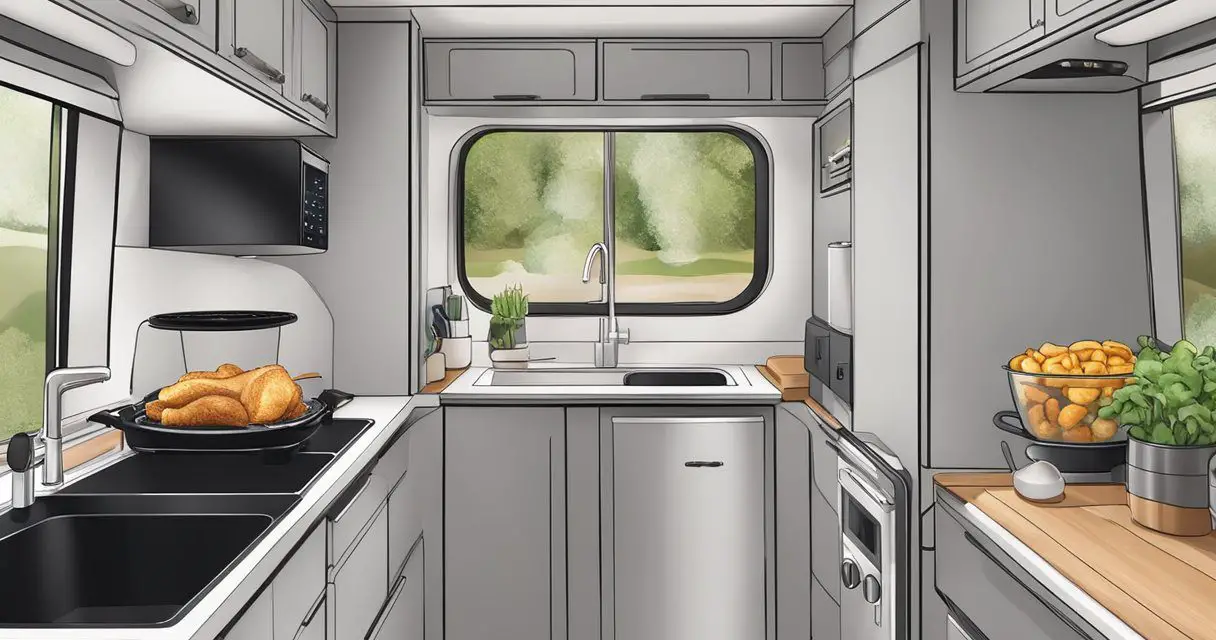Would you like to save this article?
Cooking in an RV isn’t just about surviving—it’s about thriving! While most people think a fancy stove or gourmet skills are the key, the real secret lies in working smarter, not harder.
RV kitchens are tiny, storage is limited, and propane isn’t infinite—yet some travelers whip up restaurant-quality meals without breaking a sweat. How? By mastering space, heat control, and a few genius hacks that turn cramped quarters into a culinary playground. Forget struggling over a two-burner setup; these pro tips will make you the Gordon Ramsay of the campground (minus the yelling).
1. Optimize Your Space Like a Tetris Champion
RV kitchens average just 9 square feet—smaller than a prison cell (but hopefully with better food). The trick? Multi-functional tools like an Instant Pot (pressure cooker + slow cooker + rice steamer) save space and sanity.
Collapsible colanders, nesting bowls, and magnetic spice racks keep clutter at bay. A survey by RV Life found that 72% of full-time RVers prioritize compact, stackable cookware. And if you’re not using your oven for extra storage, are you even RVing right?
If your kitchen isn’t organized like a game of Jenga, you’re leaving room for snacks—and that’s just irresponsible.
2. Cook Smarter, Not Harder (One-Pot Wonders FTW)
According to Camping World, one-pot meals reduce cleanup water usage by up to 50%—critical when you’re boondocking. Think chili, stir-fries, or pasta dishes that require just a single pan. Pre-chopping veggies at home saves time (and prevents onion tears in a 20-square-foot bathroom). Batch cooking? A Good Sam Club study showed 68% of RVers reheat leftovers to save propane.
Plus, fewer dishes mean more time for campfire s’mores—priorities!
“If you’re using more than one pot, you’re basically showing off—or punishing yourself.”
3. Hack Your Appliances (Air Fryers = RV Superheroes)
Air fryers use up to 70% less energy than a convection oven (Energy Star), making them perfect for RVs. They crisp fries, roast veggies, and even “bake” cookies without heating up your rig. Electric skillets are another MVP—35% of RVers (RVshare) use them when propane runs low. And yes, you can make a grilled cheese in a waffle iron (don’t act surprised).
“An RV without an air fryer is just a metal tent with bad snacks.”
4. Control Heat Like a Scientist (Or at Least a Semi-Responsible Adult)
RV stoves burn 20% hotter than home ranges (Forest River Forums), so dial that flame down unless you’re into charcoal-flavored eggs. A heat diffuser ($10 on Amazon) prevents scorching and evenly cooks soups. Dutch ovens? They’re the Castle Black of RV cooking—retaining heat for hours with minimal fuel. Pro tip: A laser thermometer ($15) stops guesswork and saves dinners.
“If your pancakes aren’t slightly blackened, did you even cook them over propane?”
5. Shop & Store Like a Doomsday Prepper
Canned and vacuum-sealed foods last 2-5 years (USDA), making them RV gold. Stackable bins prevent “fridge avalanches” (a leading cause of RV rage). A Camper Report survey found 89% of travelers repackage bulk foods to save space. And always, always put eggs in a secure container—unless you enjoy playing “Find the Yolk” after a bumpy road.
“If your pantry isn’t organized like a bomb shelter, you’re just camping with a death wish.”
6. Embrace Foil Packets & Disposable Liners (Zero Cleanup = Winning)
Foil packet meals (hobo dinners) are a 75-year-old camping hack (Scouts BSA) for a reason: no dishes, just flavor. Line your slow cooker with disposable bags—because scrubbing burnt cheese off at a campground sink is a special kind of misery. Even Martha Stewart approves (probably).
“If you’re washing more than one dish per meal, you’re basically on a chore-based vacation.”
Final Verdict: It’s All About Attitude
The best RV chefs don’t fight their tiny kitchen—they dominate it. Whether you’re air-frying, one-potting, or eating straight from the pan (no judgment), the key is adaptability. Now go forth and cook something delicious—preferably without setting off the smoke alarm.

